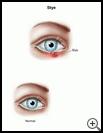
Stye
What is a stye?
A stye is a minor infection of the area where an eyelash is attached to the eye (hair follicle). It is usually caused by Staphylococcus bacteria. The stye will look like a red bump at the base of an eyelash and will be tender.
How long does it last?
It usually comes to a head and forms a pimple in 3 to 5 days. In a few more days, it usually drains and heals. It commonly comes back in children who rub their eyes. Children with a stye usually do not need to miss any school or child care.
How can I take care of my child?
- Cleansing and warm compresses
Wash the eyelids once daily with a baby shampoo. Put a warm, wet washcloth on the eye for 10 minutes 4 times a day to help the stye come to a head. Continue to cleanse the eye several times a day even after the stye drains.
- Opening a stye that comes to a head
When the stye shows a center of pus, continue using warm compresses. Most styes will open and drain by themselves in a few days after they come to a head. Sometimes a stye needs to be opened and drained by your healthcare provider. Do not try to open the stye yourself. Serious infection could spread into areas behind and around your child's eye.
- Antibiotic eye ointment
Recurrent styes or multiple styes need to be treated with an antibiotic eye ointment. These ointments do not cure styes, but they may keep them from spreading and recurring. Your child needs the eye ointment prescribed by your healthcare provider.
- Prevention
Tell your child not to touch his eyes because rubbing can cause spread of the infection.
When should I call my child's healthcare provider?
Call IMMEDIATELY if:
- The eyelid becomes very red and causes a fever.
Call during office hours if:
- The stye comes to a head and has not drained by 3 days.
- The stye is not completely healed by 10 days.
- Styes come back.
- You have other concerns or questions.
Last modified: 2012-08-29
Last reviewed: 2017-06-05

